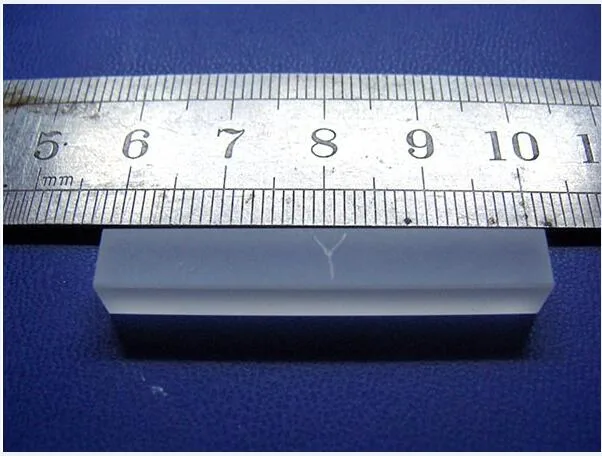Basic Info.
Model NO.
FW-CRYSTAL
Specification
costomized
Trademark
FineWin
Origin
Henan China
Product Description
Non-linear Optical Crystals (NLO Crystals) have extended the laser spectrum from deep UV to far IR by various harmonic generations (like SHG, THG, 4HG, 5HG), sum frequency generations, difference frequency generations, optical parametric oscillators, etc.
Product Description:
Potassium Titanium Oxide Phosphate (KTiOPO4 ), or KTP, is an efficient nonlinear optical crystal in the visible to infrared spectral region with relatively low cost. It has large nonlinear coefficient. The effective nonlinear optical coefficient of KTP deff at 1064nm is more than 1.5 times that of BBO. It's damage threshold is near 1 GW/cm2 for 1 Hz 10 ns pulses at 1064nm.
Application:
KTP crystal is a kind of popular nonlinear optical crystal with excellent nonlinear optical properties. As a frequency conversion optical material, KTP crystal had been widely used in scientific research and technique and many other fields, especial best for small and medium-sized power frequency doubling. Frequency doubler and photoparametric amplifier produced by KTP crystal had been had been applied in solid-state tunable laser light source. he properties of KTP make it superior as an electro-optic modulator as well as an optical waveguide device, including phase modulators, amplitude modulators and directional couplers.
Main Specification:
Advantage:
Efficient frequency conversion(1064nm SHG conversion efficiency is about 80%) Large nonlinear optical coefficients(15 times that of KDP) Wide angular bandwidth and small walk-off angle Broad temperature and spectral bandwidth High thermal conductivity (2 times that of BNN crystal ) Moisture free Minimum mismatch gradient Super-polished optical surface No decomposition below 900°C
Mechanically stable Low cost compare with BBO and LBO






Product Description:
Potassium Titanium Oxide Phosphate (KTiOPO4 ), or KTP, is an efficient nonlinear optical crystal in the visible to infrared spectral region with relatively low cost. It has large nonlinear coefficient. The effective nonlinear optical coefficient of KTP deff at 1064nm is more than 1.5 times that of BBO. It's damage threshold is near 1 GW/cm2 for 1 Hz 10 ns pulses at 1064nm.
Application:
KTP crystal is a kind of popular nonlinear optical crystal with excellent nonlinear optical properties. As a frequency conversion optical material, KTP crystal had been widely used in scientific research and technique and many other fields, especial best for small and medium-sized power frequency doubling. Frequency doubler and photoparametric amplifier produced by KTP crystal had been had been applied in solid-state tunable laser light source. he properties of KTP make it superior as an electro-optic modulator as well as an optical waveguide device, including phase modulators, amplitude modulators and directional couplers.
Main Specification:
| Main Specifications | |
| Dimension | 1x1x0.05 - 30x30x40 mm |
| Phase matching type | Type II, θ=90°; φ=phase-matching angle |
| Typical Coating | a) S1&S2: AR @1064nm R<0.1%; AR @ 532nm, R<0.25%. b) S1: HR @1064nm, R>99.8%; HT @808nm, T>5% S2: AR @1064nm, R<0.1%; AR @532nm, R<0.25% Customized coating available upon customer request. |
| Angle tolerance | 6' Δθ< ± 0.5°; Δφ< ±0.5° |
| Dimension tolerance | ±0.02 - 0.1 mm (W ± 0.1mm) x (H ± 0.1mm) x (L + 0.2mm/-0.1mm) for NKC series |
| Flatness | λ/8 @ 633nm |
| Scratch/Dig code | 10/5 Scratch/dig per MIL-O-13830A |
| Parallelism | <10' better than 10 arc seconds for NKC series |
| Perpendicularity | 5' 5 arc minutes for NKC series |
| Wavefront distortion | less than λ/8 @ 633nm |
| Clear aperture | 90% central area |
| Working temperature | 25°C - 80°C |
| Homogeneity | dn ~10-6/cm |
| Physical and Chemical Properties | ||||||||||||||||||||||
| Crystal structure | Orthorhombic | |||||||||||||||||||||
| Point group | mm2 | |||||||||||||||||||||
| Melting point | 1172°C incongruent | |||||||||||||||||||||
| Lattice parameters | a=6.404Å, b=10.615Å, c=12.814Å, Z=8 | |||||||||||||||||||||
| Temperature of decomposition | ~1150°C | |||||||||||||||||||||
| Transmition temperature | 936°C | |||||||||||||||||||||
| Mohs hardness | ~5 | |||||||||||||||||||||
| Density | 2.945 g/cm3 | |||||||||||||||||||||
| Color | colorless | |||||||||||||||||||||
| Hygroscopic susceptibility | no | |||||||||||||||||||||
| Specific heat | 0.1737 cal/g.°C | |||||||||||||||||||||
| Thermal conductivity | 0.13 W/cm/°C | |||||||||||||||||||||
| Electrical conductivity | 3.5x10-8 s/cm (c-axis, 22°C, 1KHz) | |||||||||||||||||||||
| Thermal expansion coefficients | a1 = 11 x 10-6 °C-1 a2 = 9 x 10-6 °C-1 a3 = 0.6 x 10-6 °C-1 | |||||||||||||||||||||
| Thermal conductivity coefficients | k1 = 2.0 x 10-2 W/cm °C k2 = 3.0 x 10-2 W/cm °C k3 = 3.3 x 10-2 W/cm °C | |||||||||||||||||||||
| Dielectric constant | eeff = 13 | |||||||||||||||||||||
| Optical Properties | ||||||||||||||||||||||
| Transmitting range | 350nm ~ 4500nm | |||||||||||||||||||||
| Refractive indices | nx | ny | nz | |||||||||||||||||||
| 1064nm | 1.7400 | 1.7469 | 1.8304 | |||||||||||||||||||
| 532nm | 1.7787 | 1.7924 | 1.8873 | |||||||||||||||||||
| Absorption coefficients | a < 1%/cm @1064nm and 532nm | |||||||||||||||||||||
| Therm-optic coefficients | dnx/dT=1.1x10-5/°C dny/dT=1.3x10-5/°C dnz/dT=1.6x10-5/°C | |||||||||||||||||||||
| Electro-optic coefficients |
| |||||||||||||||||||||
| Sellmeier equations | nx2=2.10468 + 0.89342λ2/(λ2-0.04438)-0.01036λ2 ny2=2.14559 + 0.87629λ2/(λ2-0.0485)-0.01173λ2 nz2=1.9446 + 1.3617λ2/(λ2-0.047)-0.01491λ2 | |||||||||||||||||||||
| Nonlinear Properties | ||||||||||||||||||||||
| Phase matching range | 497nm - 3300 nm | |||||||||||||||||||||
| Nonlinear coefficients (@ 10-64nm) | d31=2.54pm/V, d31=4.35pm/V, d31=16.9pm/V d24=3.64pm/V, d15=1.91pm/V at 1.064 mm | |||||||||||||||||||||
| Effective nonlinear optical coefficients | deff(II)≈ (d24 - d15)sin2qsin2j - (d15sin2j + d24cos2j)sinq | |||||||||||||||||||||
| Type II SHG of 1064nm Laser | ||||||||||||||||||||||
| Phase matching angle | q=90°, f=23.2° | |||||||||||||||||||||
| Effective nonlinear optical coefficients | deff »8.3 x d36(KDP) | |||||||||||||||||||||
| Angular acceptance | Dθ= 75 mrad Dφ= 18 mrad | |||||||||||||||||||||
| Temperature acceptance | 25°C.cm | |||||||||||||||||||||
| Spectral acceptance | 5.6 Åcm | |||||||||||||||||||||
| Walk-off angle | 1 mrad | |||||||||||||||||||||
| Optical damage threshold | 1.5-2.0MW/cm2 | |||||||||||||||||||||
Advantage:
Efficient frequency conversion(1064nm SHG conversion efficiency is about 80%)
Mechanically stable












